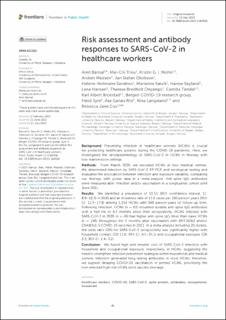| dc.contributor.author | Bansal, Amit | |
| dc.contributor.author | Trieu, Mai Chi | |
| dc.contributor.author | Mohn, Kristin Greve-Isdahl | |
| dc.contributor.author | Madsen, Anders | |
| dc.contributor.author | Olofsson, Jan Stefan | |
| dc.contributor.author | Sandnes, Helene Heitmann | |
| dc.contributor.author | Sævik, Marianne | |
| dc.contributor.author | Søyland, Hanne | |
| dc.contributor.author | Hansen, Lena | |
| dc.contributor.author | Onyango, Therese Bredholt | |
| dc.contributor.author | Tøndel, Camilla | |
| dc.contributor.author | Brokstad, Karl Albert | |
| dc.contributor.author | Syre, Heidi | |
| dc.contributor.author | Riis, Åse Garløv | |
| dc.contributor.author | Langeland, Nina | |
| dc.contributor.author | Cox, Rebecca Jane | |
| dc.date.accessioned | 2023-10-13T07:39:06Z | |
| dc.date.available | 2023-10-13T07:39:06Z | |
| dc.date.created | 2023-07-06T12:49:27Z | |
| dc.date.issued | 2023 | |
| dc.identifier.citation | Frontiers in Public Health. 2023, 11 . | en_US |
| dc.identifier.issn | 2296-2565 | |
| dc.identifier.uri | https://hdl.handle.net/11250/3096294 | |
| dc.description.abstract | Background: Preventing infection in healthcare workers (HCWs) is crucial for protecting healthcare systems during the COVID-19 pandemic. Here, we investigated the seroepidemiology of SARS-CoV-2 in HCWs in Norway with low-transmission settings.
Methods: From March 2020, we recruited HCWs at four medical centres. We determined infection by SARS-CoV-2 RT-PCR and serological testing and evaluated the association between infection and exposure variables, comparing our findings with global data in a meta-analysis. Anti-spike IgG antibodies were measured after infection and/or vaccination in a longitudinal cohort until June 2021.
Results: We identified a prevalence of 10.5% (95% confidence interval, CI: 8.8–12.3) in 2020 and an incidence rate of 15.0 cases per 100 person-years (95% CI: 12.5–17.8) among 1,214 HCWs with 848 person-years of follow-up time. Following infection, HCWs (n = 63) mounted durable anti-spike IgG antibodies with a half-life of 4.3 months since their seropositivity. HCWs infected with SARS-CoV-2 in 2020 (n = 46) had higher anti-spike IgG titres than naive HCWs (n = 186) throughout the 5 months after vaccination with BNT162b2 and/or ChAdOx1-S COVID-19 vaccines in 2021. In a meta-analysis including 20 studies, the odds ratio (OR) for SARS-CoV-2 seropositivity was significantly higher with household contact (OR 12.6; 95% CI: 4.5–35.1) and occupational exposure (OR 2.2; 95% CI: 1.4–3.2).
Conclusion: We found high and modest risks of SARS-CoV-2 infection with household and occupational exposure, respectively, in HCWs, suggesting the need to strengthen infection prevention strategies within households and medical centres. Infection generated long-lasting antibodies in most HCWs; therefore, we support delaying COVID-19 vaccination in primed HCWs, prioritising the non-infected high-risk HCWs amid vaccine shortage. | en_US |
| dc.language.iso | eng | en_US |
| dc.publisher | Frontiers | en_US |
| dc.rights | Navngivelse 4.0 Internasjonal | * |
| dc.rights.uri | http://creativecommons.org/licenses/by/4.0/deed.no | * |
| dc.title | Risk assessment and antibody responses to SARS-CoV-2 in healthcare workers | en_US |
| dc.type | Peer reviewed | en_US |
| dc.type | Journal article | en_US |
| dc.description.version | publishedVersion | en_US |
| dc.rights.holder | © 2023 Bansal, Trieu, Mohn, Madsen, Olofsson, Sandnes, Sævik, Søyland, Hansen, Onyango, Tøndel, Brokstad, Bergen COVID-19 research group, Syre, Riis, Langeland and Cox | en_US |
| dc.source.pagenumber | 13 | en_US |
| dc.source.volume | 11 | en_US |
| dc.source.journal | Frontiers in Public Health | en_US |
| dc.identifier.doi | 10.3389/fpubh.2023.1164326 | |
| dc.identifier.cristin | 2161218 | |
| cristin.ispublished | true | |
| cristin.fulltext | original | |
| cristin.qualitycode | 1 | |

